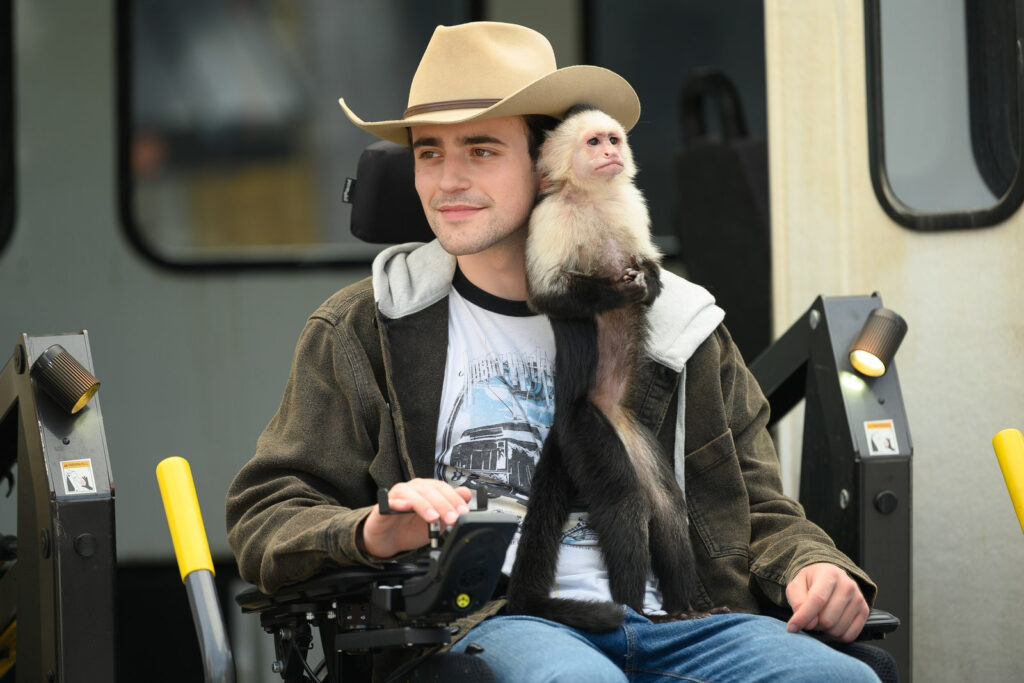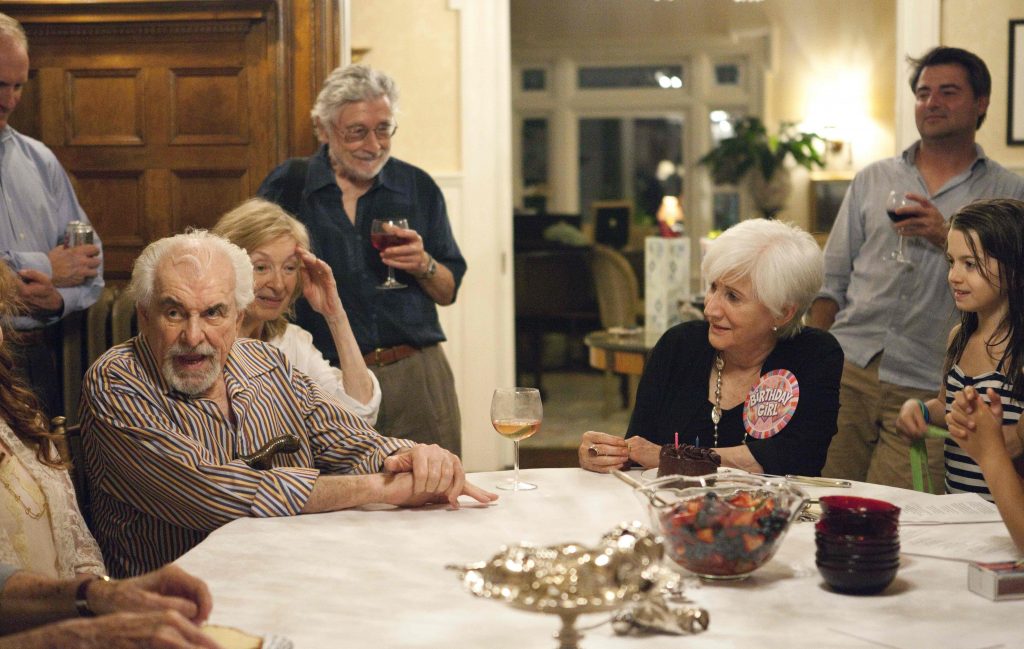September 8, 2022
by Carla Hay

Directed by Nick Hamm
Culture Representation: Taking place over a five-year period in Tennessee and briefly in North Carolina, the dramatic film “Gigi & Nate” features a predominantly white cast of characters (with a few African Americans and Latinos) representing the working-class and middle-class.
Culture Clash: After getting quadriplegia at the age of 18, Nate Gibson’s life is changed at the age of 22, when he gets a capuchin monkey named Gigi as a service animal, but that special relationship is threatened when an animal-rights activist group works to ban capuchin monkeys as household pets.
Culture Audience: “Gigi & Nate” will appeal primarily to people who don’t mind watching sappy and frequently boring melodramas about cute animals.

If the adorable capuchin monkey in “Gigi & Nate” could speak a human language, she would say, “Get me out of this embarrassing movie.” The monkey is the best thing about this overly sappy, tedious and predictable melodrama. Unfortunately, the trailer for “Gigi & Nate” already reveals about 90% of the movie’s plot. The story’s main conflict is rushed in the last third of the film. And so, that leaves the first-two thirds of “Gigi & Nate” to be a lackluster slog of a self-pitying young man with quadriplegia who starts to have a more positive attitude about life when he gets a capuchin monkey as a service animal.
Directed by Nick Hamm and written by David Hudgins, “Gigi & Nate” doesn’t start off as a terrible film. The last third of the movie, which is supposed to be the best part, is what’s mishandled the most and thereby ruins the movie. In the beginning of “Gigi & Nate,” 18-year-old Nate Gibson (played by Charlie Rowe) is spending his summer vacation with his family in an unnamed city in Tennessee. (“Gigi & Nate” was actually filmed in North Carolina.)
Life is going very well for Nate, who lives several miles away in Nashville and is about to go to an unnamed university in the fall. One day during this vacation, Nate goes with some other young people to an outdoor swimming hole located near some cliffs. Accompanying him on this swimming outing are Nate’s feisty older sister Katy (played by Josephine Langford); Katy’s boyfriend Travis Holter (played by Emilio Garcia-Sanchez); Benji Betts (played by Olly Sholotan); and 17-year-old Lori (played by Zoe Colletti, also known as Zoe Margaret Colletti), who has recently stuck up a mild flirtation with Nate. Lori met Nate at the fireworks outdoor stand where she works.
Nate is a bit of a daredevil, so he takes a dare to jump of a cliff and do a back flip into the water. The water is deep enough not to cause him any injuries. But when Nate emerges from the water, he looks slightly disoriented. It’s a foreshadowing of what’s to come later.
After this swimming trip, Nate is having dinner with family members and friends. In addition to Nate and Katy, the other members of the Gibson family who are on this vacation are Nate’s outspoken homemaker mother Claire Gibson (played by Marcia Hay Harden); Nate’s mild-mannered younger sister Annabelle (played by Hannah Riley), who’s about 15 years old; and Claire’s sassy and sometimes-crude mother Mama Blanche (played by Diane Ladd). Claire’s husband, Dan Gibson (played by Jim Belushi), who is the family patriarch, is away on a business trip.
Nate tells his mother that he’s having very painful headaches, and she advises him to take some aspirin. But what’s wrong with Nate can’t be fixed with aspirin. He collapses in the bathroom, and he ends up in a hospital. Dan is called away from his business trip for this emergency, and he frantically rushes to be with Nate and the rest of the family.
The medical diagnosis is that Nate contracted amoebic meningitis from the water he ingested during that fateful swimming excursion. The meningitis has left him with quadriplegia (paralysis of his arms and legs) and needing to use a wheelchair to move around. Early on in Nate’s hospitalization, Claire makes the decision to have Nate sent by helicopter to their home city of Nashville, where he can get advanced medical care.
This medical condition is emotionally devastating to Nate and his loved ones. He becomes hopeless and bitter, and he spends the next four years of his life basically being a shut-in, because Claire is overprotective and doesn’t want Nate to spend a lot of time outside in public. At one point, Nate becomes so depressed, that when he’s outside in his home’s backyard, he tilts his wheelchair so that he deliberately falls into the backyard pond. It’s a huge cry for help instead of a serious suicide attempt, because Dan is nearby in the backyard, and he immediately rescues Nate.
When Nate is 22 years old, his life changes for the better when Claire comes up with the idea to get Nate a service animal to keep Nate company and to give him encouragement and a better motivation to live. And that’s when capuchin monkey Gigi (played by Allie) comes into Nate’s life. Gigi, who was rescued from a petting zoo, does all the expected things that inspirational pets do in movies like “Gigi & Nate.”
Gigi cheers up Nate when he’s feeling depressed and anxious. Gigi is an enthusiastic assistant during Nate’s physical therapy sessions. Gigi also makes human-like expressions on her face to show that she has a distinct personality and feelings. (Some CGI effects were used in some of the monkey scenes.)
In other words, Gigi helps Nate come out of his reclusive shell. He starts to venture out in public more, with Gigi as his constant companion. One day, Nate is at a local grocery store with Gigi and his mother Claire, and he sees Lori working at the store as a stock clerk.
Lori has not seen or kept in touch with Nate since the day at the swimming hole. And so, at first, Lori doesn’t recognize Nate when they see each other. His hair is longer than it was that day, and he’s now in a wheelchair. Lori is shocked to see Nate in a wheelchair, and she bluntly asks him what happened. She then profusely apologizes for coming off as a little harsh.
Nate tells Lori why he now has quadriplegia, and that Gigi is his service animal. Lori is utterly charmed by Gigi, and she encourages Nate to set up a social media account to document his life with Gigi. And you know what that means later in the story: The videos go viral, and Nate becomes a little famous. Nate and Lori also get closer to each other, since there’s still a romantic spark between them.
At the grocery store where Nate and Lori had their unexpected reunion, someone sees Gigi in the store and isn’t happy about it at all. Her name is Chloe Gaines (played by Welker White), the Tennessee chapter president of Americans for Animal Protection. It’s a group that works to ban certain wild animals as pets in private households, because the group believes these animals should be in a more natural habitat.
Chloe tersely confronts Claire and Nate and informs them that the monkey shouldn’t be in the grocery store because it’s a violation of health code laws. And even though this movie depicts Chloe as a meddling, unreasonable shrew, she is right about the health code violation. Nate allowed Gigi to climb all over the packaged food on the grocery store shelves. As cute as this monkey is, it’s just not sanitary to have animals crawling over food in a grocery store or any place that sells and stores food.
Claire and Nate are very defensive and tell Chloe that Gigi is not just a pet. Gigi is a working service animal. But that’s not a good-enough explanation for Chloe. As shown in the trailer for “Gigi & Nate,” Chloe becomes the “villain” of the story, as she launches a campaign over the next year to ban capuchin monkeys as household pets in Tennessee. The trailer also shows that Gigi gets taken away from Nate. This conflict is crammed in too late in the movie’s last half-hour.
The Gibson family is in regular contact with Carolyn Albion (played by Mishel Prada), the leader of the animal rescue group that saved Gigi from mistreatment at the petting zoo. She’s on the Gibson family’s side in their battle against the Tennessee chapter of Americans for Animal Protection. Nate also has a caretaker named Nogo (played by Sasha Compère), who is also part of the Gibson family’s support system.
The only crucial plot point that isn’t shown in movie’s trailer is how the conflict is ultimately resolved. That part is hastily and sloppily contrived and shown in the movie’s last 10 minutes. It all comes across as very shallow and cloying.
“Gigi & Nate” has a talented cast, but most of the supporting characters are written in a bland way. Mama Blanche has a few lines of dialogue as cheeky zingers, but she’s mostly a sidelined character. Harden and Rowe, as Claire and Nate, have some poignant mother/son moments, while Belushi’s Dan character is a workaholic who has arguments with Claire about Nate’s ongoing care. Dan thinks Claire is overly cautious, and he believes that Nate should have more freedom.
As soon as the monkey comes into the picture as Nate’s service animal, “Gigi & Nate” becomes more about the animal antics and less about the human psychological challenges of adjusting to life with quadriplegia. If the filmmakers thought this psychological angle would be too depressing, then they still could’ve made “Gigi & Nate” a better movie if they made the conflict of the Gibson family versus Americans for Animal Protection a bigger part of the story. That’s why the movie’s showdown scene in a Tennessee state legislative hearing is very truncated and anticlimactic.
“Gigi & Nate” isn’t a completely terrible movie, because the acting performances are competent. It’s just a disappointing film that handles many important issues in a very cringeworthy way that overloads on being hokey, and thereby cheapens the intended messages of the movie. “Gigi & Nate” has some appealing monkey scenes, but is missing a lot of the realistic human grit needed to make this movie more interesting and meaningful.
Roadside Attractions released “Gigi & Nate” in U.S. cinemas on September 2, 2022.




